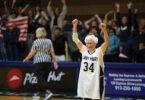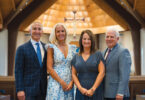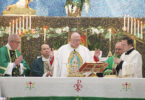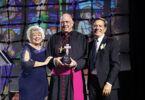Music therapy brings joy to the dying
by Lajean Rau-Keene
When Nora Drbal was nine years old, she sang for a dying woman. “The experience never left her.”
Her family was visiting her great-aunt, so her grandmother could say goodbye to her sister.
The woman’s room was near the main entry of the farmhouse.
“It was not isolated. It was like, ‘This lady is dying, and this is part of life,’” said Drbal, now 63 and a music therapist for Catholic Community Hospice.
“My grandma introduced me to her sister. And then she turned to me and said, ‘Nora is going to sing some songs for you.’”
Her grandmother encouraged the nervous girl, suggesting she sing some of the Irish songs her mother had taught her.
“I liked it. And they liked it,” Drbal said. “It was just a very nice experience. I always had that in my heart. It was always there.”
Many years later, after working part time as a music teacher while raising her children, Drbal went back to school to become a music therapist. Today, it is her job to sing for terminally ill patients. Catholic Community Hospice, a program of Catholic Charities of Northeast Kansas, began offering the therapy about a year ago when it first contracted with Drbal, a board-certified music therapist, who got her training at the University of Kansas.
On a recent morning, Drbal visited Mary Fields at Delmar Gardens nursing center in Overland Park. She played her guitar and sang old popular songs like “Side by Side,” “(I’ll be Loving You) Always,” “Let Me Call You Sweetheart” and “Sentimental Journey.”
Mary, who has had Alzheimer’s disease for more than six years, rarely speaks and is inactive. but while Drbal sang and played, she moved slightly with the music, smiled broadly several times and even spoke. (“Did you like that song, Mary?” “Yes, I did.”) She closed her eyes and dozed off during a soft and slow version of “Edelweiss.”
Bill, 79, and Mary, 77, longtime members of Holy Cross Parish in Overland Park, were married 55 years in September. Bill, who held Mary’s hand during most of the session, cared for his wife in their home for four years after her diagnosis; she has been at the nursing center for the last two. Drbal has been seeing Mary for about 10 months, not just playing guitar and singing for her, but interacting with her in a loving and playful way. Bill is pleased with the therapy.
“I think it has been very beneficial to her,” he said. “She has these involuntary motions. You noticed her tongue movement. Also occasionally she has had hand and arm movements. Just fidgeting. The music Nora provides for her removes all of that from her. She completely relaxes. Sometimes she will even fall into a deep sleep.”
Drbal said the biggest misconception about her work is that the music is just for entertainment.
“People may not understand why music therapy with a guitar would be more valuable than just turning on the radio,” she said.
But research bears out its many benefits for hospice patients: from relieving pain and agitation to providing an opportunity for communication and connection with loved ones.
Andy Duncan, of the National Hospice and Palliative Care Organization, said that most hospices incorporate music into their care, but music therapy with clinical goals is different.
Music therapy began showing up in a lot of hospice programs in the mid ’90s, he said, and “really took off and started to grow exponentially in the late ’90s and early 2000s.”
“It’s regional, in that there are a great deal of music therapy programs where others have started because it demonstrated such clinical benefit that it actually gave [those hospices] a marketing advantage,” he said.
Drbal’s sessions are often weekly, typically 30 or 45 minutes long, and sometimes longer depending on the patient and the family. She usually plays guitar or keyboard and sings. Sometimes, particularly when there are chil- dren, she will bring small percussion instruments.
The therapy can be interactive, or the patient and family may just listen. It can include song writing, discussion of lyrics, use of imagery and chanting. It is carefully tailored to each patient.
“That’s the first rule of thumb,” Drbal said. “Pick music the patient will like and respond to.”
Often songs will elicit memories, taking patients back to better times.
“If you can find the right song or grouping of songs, you will start to see they’re there with you,” she said. “They may be songs that brought a couple together. When a wife reaches over to hold her husband’s hand, it’s just the most fulfilling feeling.”
One challenge for Drbal is learning new music. She knows many songs from the ’30s to the ’40s and ’50s, for example. but some of her patients are younger.
Like the Vietnam veteran who wanted a “celebration of life” service before he died.
“He liked rock ’n’ roll, Bob Seger, that kind of thing,” said Drbal.
She spent two-and-a-half hours with him one day, playing and learning songs, and just talking. He wanted to put some of his poetry to music.
“I asked him to pick six poems,” Drbal said. but he died before they could com- plete their work.
The man’s family and brother Daryl Charron, chaplain with Catholic Com- munity Hospice, incorporated some of the music into the man’s funeral.
“He was down and music brought him up,” said Drbal, who has participated in funerals and memorial services for many of her patients.
Tiffany James, a registered nurse and executive director of Catholic Community Hospice, said the work Drbal is doing has helped a lot of families.
“We had one patient who had some young children,” James said. “The family, because [the woman] was so young, was just not able to talk about death, to say the word death, to even have those conversations. When we bring Nora in, she’s able to do that through music.
“After a couple of weeks of using music therapy, the family, the children, were able to talk about what was going to happen to Mom and what they were going to do.”
“Another place we tend to put her in,” James said, “is when a patient has dementia. A lot of times the patient can’t necessarily carry on a conversation anymore. . . . but they tend to really react to the music. You can tell they are enjoying it. It relaxes them. And so we’ve seen some great benefits on that end.”
Drbal tells many touching stories about her patients.
Like the woman with Alzheimer’s she saw only once.
“The husband was there,” she said. “I asked, ‘Is there any music that might help you?’” He requested ‘Ave Maria’ because 60 years prior, a priest had not allowed the song at their wedding, saying the arrangement was ‘too secular.’”
“She finally got her ‘Ave Maria,’” he said. The woman died that night.
There was another patient with Alzheimer’s who slept a lot of the time. Drbal sang the same songs to her every week. One day, Drbal found the woman awake.
“She started singing,” said the therapist. “The nurses couldn’t believe it. They said she only speaks gibberish.
“The son told me, ‘I have never heard my mom sing. Ever.’”
“It didn’t take her out of Alzheimer’s, but it was her communicating,” concluded Drbal. “She was hearing and benefiting from it.”
Still another patient was a grandfather with cancer. He didn’t have long to reconnect with his grandkids after he moved in with his daughter, who wanted to leave the children with positive memories of their grandpa. They found common ground with the Beatles and Elvis.
Recalling some of her other patients’ stories brings a broad smile to Drbal’s face. Like the man who wanted her to sing “Hey, Hey, Good Lookin’” to his open casket. (She did.)
Or the couple who requested “Going to Kansas City” and “bad, bad Leroy brown” for the woman’s funeral.
“We did them in the room, and she started dancing in her wheelchair,” said Drbal, laughing.
Or the professional harmonica player who agreed to have her work with him under one condition: She would learn to play the harmonica. Not only did Drbal learn to play the harmonica, she played with him and his band in two final concerts at a nursing home where he used to perform.
“He wanted one more concert and one more student,” said Drbal, who still plays with the band, though the patient has died.
Music therapy is not for everyone. A small percentage of Catholic Community Hospice patients receive the therapy. Some patients and families are not interested. but most just don’t know much about it.
Back at Delmar Gardens, Drbal was singing “Que Será Será” to Mary, when she began extending her hand out toward the guitar. Drbal removed the strap, continuing the song a cappella, and presented the guitar to Mary, who held it for a long time, not wanting to let go. She slowly traced designs on the body with her fingertips and felt the strings while Drbal and bill talked.
When Mary finally loosed her grip on the instrument, Drbal began the last song of the session, the traditional Scottish “When You and I Were Young, Maggie,” substituting Mary’s name for Maggie’s.
Bill sang along quietly, eyes on his wife.
“And now we are older and grey, Mary. Our time on earth nearly done. Let us sing of the days that are gone, Mary, when you and I were young.”
Tears came to Drbal’s eyes even in the telling, as they had several times throughout the interview.
“I love my job,” Drbal said emphatically. “People say, ‘Isn’t it sad?’
“No! There’s so much joy. I have the greatest job in the world.”






